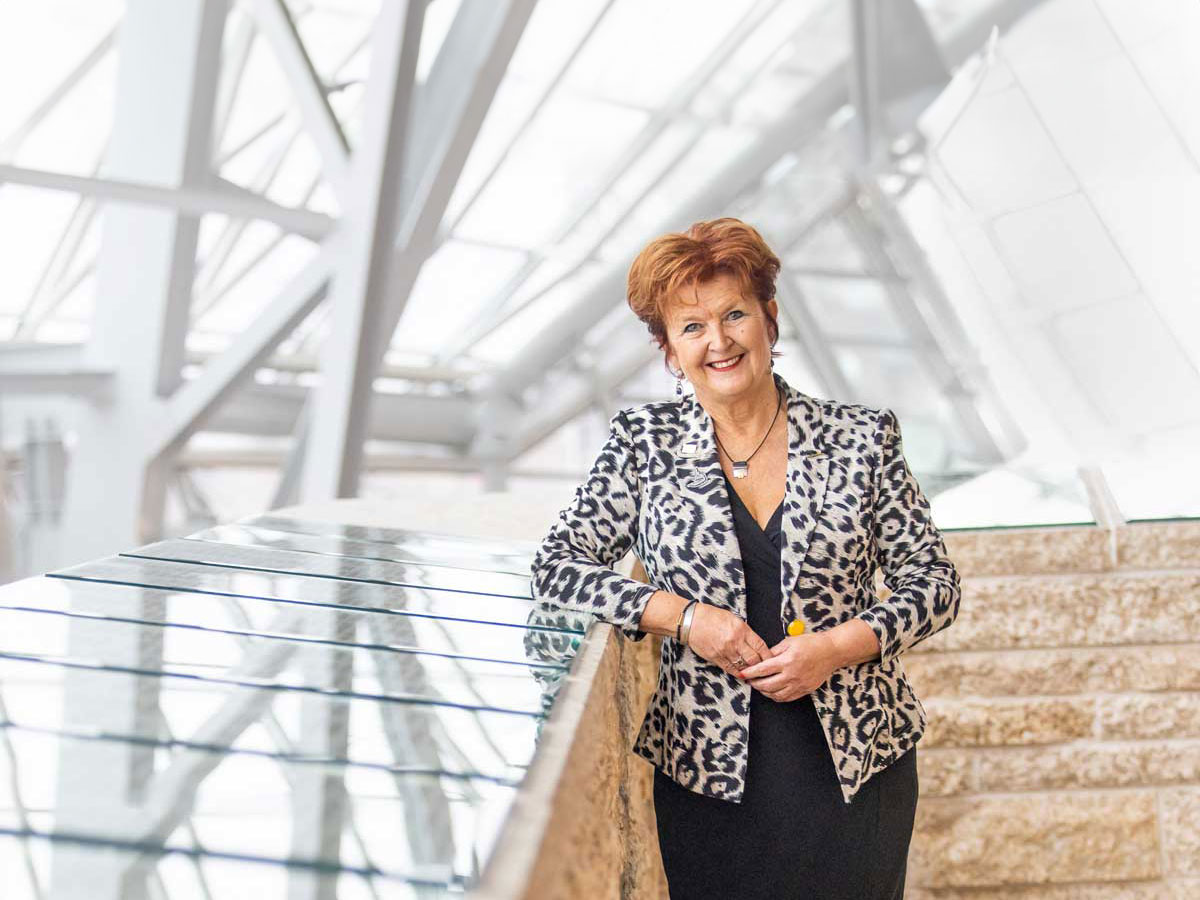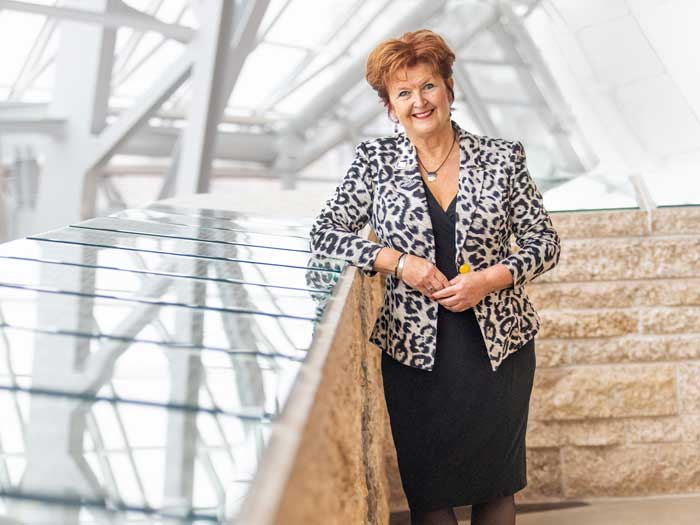
This FCPA helped build Canada’s first human rights museum
 Susanne Robertson was the Canadian Museum of Human Rights’ first employee (Photography by Matthew Sawatzky)
Susanne Robertson was the Canadian Museum of Human Rights’ first employee (Photography by Matthew Sawatzky)
Overlooking Winnipeg’s stretch of the winding Red River is the Canadian Museum for Human Rights, a stunning glass, alabaster and steel behemoth sprawled across nearly six acres of floor space. It’s a project of many firsts: the first museum solely dedicated to the exploration of human rights around the world, Canada’s first national museum in more than 40 years and the first ever national museum outside Ottawa.
Susanne Robertson, its CFO, was the museum’s first employee when she was appointed to her role in 2008. She played an integral role in developing it from the literal ground-up—one of her first jobs was securing the building’s construction budget. That work, along with a long history volunteering on the boards of not-for-profits like the Arthritis Society and Ovarian Cancer Canada, won her the 2016 Financial Leadership (CFO) Award as part of Chartered Professional Accountants of Canada’s Awards of Excellence in Public Sector Financial Management and, in 2019, a Fellow CPA (FCPA) designation in Manitoba.
“The FCPA awards ceremony was held at the museum,” she says. “My family and many of my peers attended. To be recognized for my work in a place that means so much to me was very special.” After 15 years with the museum and its charitable wing, Robertson is preparing to retire. Looking back at her career, she says her passion for making a real impact on the world—fueled by the energy and commitment of her coworkers—has kept her grounded through it all.
PIVOT: You held senior positions at a real estate startup firm and a printing company before joining the foundation for the museum as CFO and project manager. What attracted you to the museum?
SUSANNE ROBERTSON (SR): Early in my career, I started volunteering on the boards of not-for-profit organizations. Initially, it was small things like the board of my kids’ daycare, but I eventually became the chair for the regional and then national Arthritis Society and now sit on the board of Ovarian Cancer Canada. Those positions taught me that working in something with meaning behind it gives me a lot of satisfaction. I saw it as the opportunity of a lifetime—the opportunity to work in something meaningful, while combining my CPA training with my not-for-profit experience and work scaling a startup.
PIVOT: What was it like being the first employee of Canada’s first new national museum in more than 40 years?
(SR): At the time, we had no building or exhibits, no policies or procedures, no staff and, most importantly, no how-to manual, since there hadn’t been a national museum established in such a long time. Six years later, we opened a magnificent building with almost 200 staff and hundreds of volunteers. My CPA training—my analytical skills, decision-making, problem solving and appetite to assess risk—helped a lot along the way. As a CFO, you get involved in everything, because there is always a financial aspect. There were some tricky moments that drew directly on my CPA skill set.
PIVOT: Can you describe one of those moments?
(SR): In the fall of 2008, shortly after our first board meeting, a $265 million budget had been set. But, due to significant escalation in construction cost at that point in time, we needed significantly more funds than that. We had to work with the construction company, architects, and engineers to analyze the situation and provide options and recommendations to the board around what could be done to bring the budget down to a more reasonable amount—all without sacrificing the original vision for this iconic building. It was nerve-wracking; the board could have decided to build something lesser. But, for a museum in the centre of the country handling such important subject matter, I felt it was crucial to preserve the original vision.
PIVOT: You’ve said that the museum is the first of its kind. Can you elaborate on that?
(SR): It’s the world’s first museum solely dedicated to the evolution, understanding, and celebration of human rights. We take a broad lens to human rights around the world, though there’s a focus on reflecting and furthering Canada’s commitment to human rights. At various stages in the process, we incorporated third-party audits to make sure we have a good cross-section of human rights issues from around the world. It’s also unique in that we’re Canada’s first national museum outside Ottawa and we’re not a traditional collecting museum—we generally borrow artifacts, rather than own them.
PIVOT: What exhibits have had a particularly strong impact on you?
(SR): One of our core exhibits is the Canadian Journeys gallery. It has 18 alcoves dedicated to different stories related to Canada’s human rights history, from disability rights and same-sex marriage to residential schools. You could spend days in that one gallery. In the centre of it there’s a game called Lights of Inclusion. When you walk in, a circle of light forms around you and, when people come in to stand there with you, it becomes brighter, and ribbons of light move through the space. It’s about how we do better when we work together.
PIVOT: Is there any programming planned around the war in Ukraine?
(SR): We’re in ongoing conversations with the Ukrainian community about how we can mark these terrible events going forward. One of our current exhibits focuses on the Holodomor—a man-made famine in Soviet Ukraine from 1932-1933 that killed millions of Ukrainians. Like many organizations around the world, we lit up our building in blue and yellow at the time to show our support.
PIVOT: You’re planning to retire this summer. Why now, and what are your plans for retirement?
(SR): It was a very hard decision, even though I’ll be 67 in November. Being part of something so important and meaningful—not just for human rights, but for my community in Winnipeg—was an incredible experience. But the museum is in a really good place right now and it feels like the right time to give someone else an opportunity to come in with new ideas. I’m in a good place, as well—it’s time for me to enjoy other things in life, like travelling and spending time with my grandkids. But I like to keep my hands in things, so I may apply to be on the board of one of the other national museums or a different board opportunity. I feel truly honoured to end my career on this note; the museum became my baby after my children were grown. It will be hard to give up.
MEET OTHER INSPIRING CPAS
Read about the CPA shaping the CFL; Ontario’s first comptroller general to hold a deputy minister title and how one CPA is working to resurrect Cirque du Soleil.